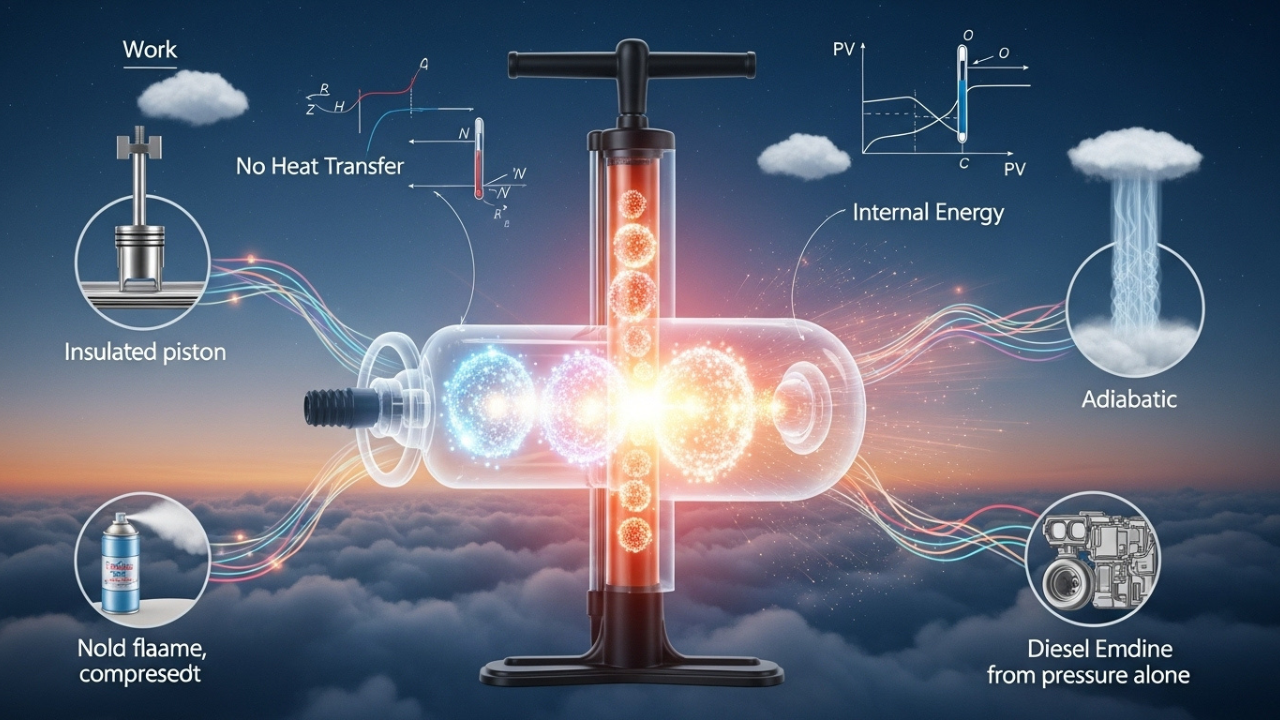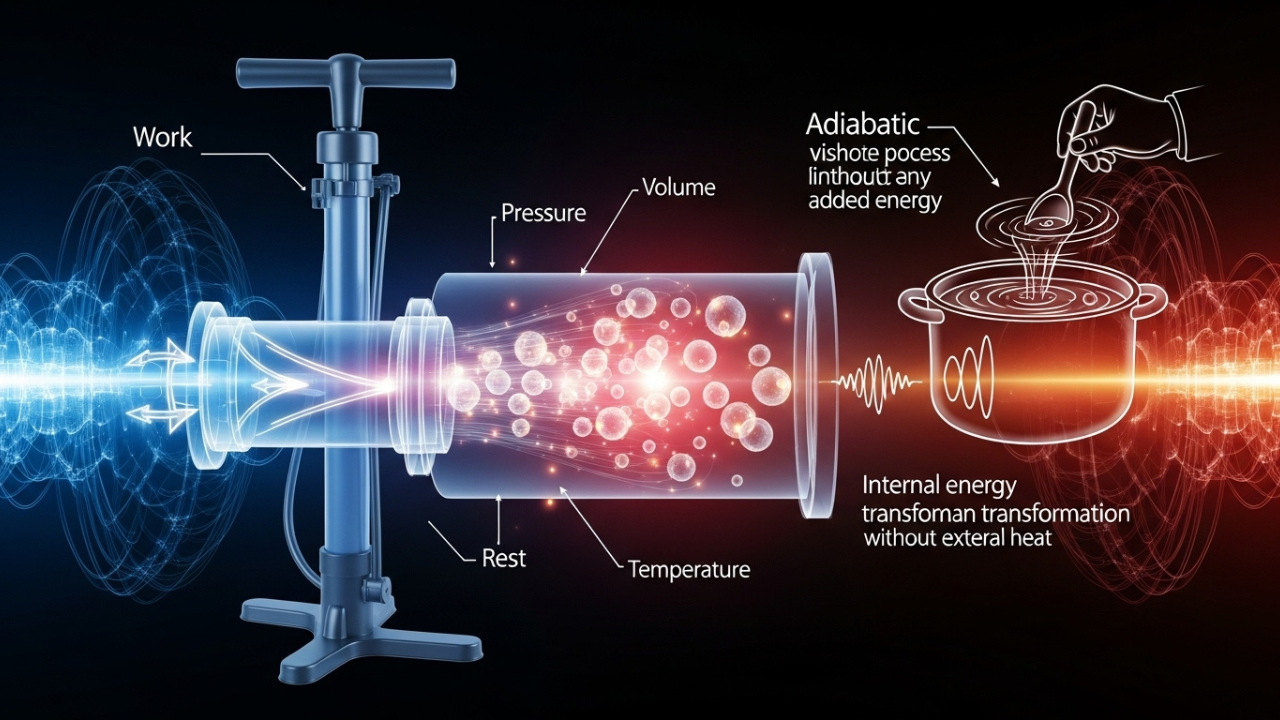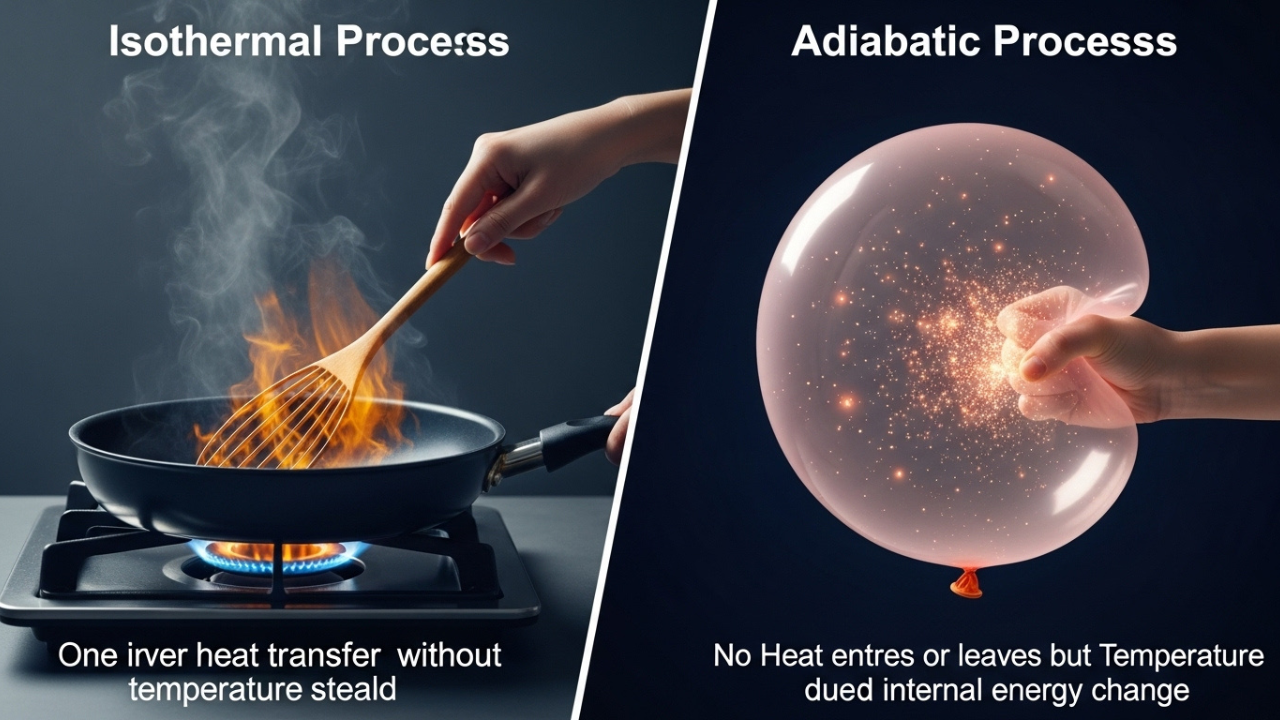How about we start things off with a fundamental scenario. Imagine the weather is warm outside and you are inflating your bicycle’s tire. The air pump itself feels warm, specifically the portion that touches your hands moves up and down.
The metal feels hot to touch while the air is still warmer, so where’s the fire, heating coils, or other sources of electricity available?
We can easily dismiss all of this a case of exercise heat or friction, however, what is happening here is simply more interesting beneath the surface.
Adiabatic process leaves traces of itself in your everyday experience.
We are still trying to understand the reason as to why the air pump self heats without touching a heater. While it’s obvious that no heating from the outside is applied, heat still increases and thus can be measured. To simply put it, this works in the fundamentals of adiabatic process, which is not what goes into the system, energy already present inside is used. By the time we conclude this, I assure you, it will become intuitive, not just in theory but in reality.
Key Takeaways
- As an example, adiabatic processes do take place in every day life when there is no transfer of heat made inside or outside the system.
- But no worries if al of this confuses you, adiabatic as well as temperature change does occur under compression or expansion without any heat flow.
- Rapid processes such as fast compression take place with high speed under adiabatic conditions as heat cannot escape the system.
- You observe adiabatic changes in a bike pump, an engine, and in rising columns of air.
- Realizing this shift shows how energy relocates internally without the input or output of heat.
Unpacking the Idea: What Adiabatic Really Means
One human definition would be that an adiabatic process is one where no heat goes in or out of a system. Not because heat is non-existent, but rather that the system is sealed away from it. During such a process, any shift in temperatures must be self generated. For instance, the gas inside a container is said to be heated because it’s not due to any added heat, but rather commotion within the gas itself after it was concentrated. When the gas cools, it can be said that gas expands and its energy diffuses.
Think of a piston which is insulated and sealed that contains air. When you push hard and fast on the piston, gas inside is unable to thepyy off any heat to the surrounding environment. The molecules will collide into each other more vigorously leading to increase in internal energy which in turn will increase the temperature. The heat that is generated is not because of the room or your hands, but because of the energy that is supplied through constricting the system. The term adiabatic comes into context here. The energy did not move, only the heat.
Why Speed Changes Everything in an Adiabatic Moment
Time is a more critical issue than you might think. If a change occurs instantaneously, a system does not have the time to adjust. The air cannot undergo a heat exchange with its environment because it happens before that can occur. This is also the reason an adiabatic process most of the time contains rapid expansion or compression. If you slowly compress a gas, it can cool by releasing heat. But if you do it quickly, all that energy will be trapped and temperature will rise exponentially.
While this is applicable in the reverse form as well, releasing the air suddenly from a tire, or spraying an aerosol can, will instantly drop the pressure. The gas expands. And that expansion absorbs energy from within, leaving the surrounding cooler. That is why the can feels cold. It didn’t suck heat from your hand, it simply lost internal energy in an instant. There wasn’t enough time to draw warmth from the surroundings, and there wasn’t enough room from out. Only the system doing what it must, on its own terms.
The Role of Work: How Force Turns Into Temperature
Now let’s return to that bicycle pump. When you compress air, you do work on it. Not only does it move the piston, but work during compression adds energy (not heat, but mechanically as pressure) to the system. Such energy becomes part of the system and alters the way particles are supposed to move. They begin to collide with each other harder, faster, and more often. What we experience externally is heat.
In adiabatic processes, the work done changes the the temperature in the system and not heat transfer. Picture twirling a spoon in a pot of soup and adding nothing. No heat was provided, but motion was applied. That motion will, in the end, modify the system’s energy. In this scenario the energy is internal, the pressure is volume, and the change is the difference in temperature.
Let’s narrow down the focus to spheres that are relevant to us. For this example the idea of energy flows is important as well as the fact the system is undergoing a change.
Internal Energy: The Hidden Hand Behind Adiabatic Shifts
The same technique can be applied while thinking of internal energy. Think of the molecules that make up a gas as tiny balls that are vigorously bouncing in a closed box. When you compress that box, the balls are packed tighter together.
As a result, it is also observed that the balls do not stop hitting each other with an increased force. Because of that, their kinetic energy increases which leads to the temperature of the system increasing as well. Not because any form of heat came from the outside, but rather, you did some work which changed their motion.
As you let the box expand, the balls are allowed to move apart. When that happens, they less frequently collide with one another. The energy becomes more dispersed and because of that, the system cools down while you did not remove any heat. You simply allowed the energy to stretch over a larger space which is what caused the drop in pressure and in turn, leads to a subsequent drop in energy. Temperature follows and results in the cooling system. These processes become beautiful to observe. They showcase the transformation of internal energy becoming heat, but without transferring it.
Where You See Adiabatic Processes in Everyday Life
This is where the adiabatic processes will get even more interesting, Explorer. Adiabatic processes occur more often in your surroundings than you actually think. For example, when a parcel of air is rising through the atmosphere, it is expanding due to low pressure at higher altitudes. Due to less surrounding pressure, the air parcel cools. It does not cool by losing heat to its environment but rather has to internally ‘spend’ energy which results in decreased heat. This type of cooling is called adiabatic cooling. This is responsible for cloud formation and different weather patterns.
Think of a more practical example, such as when you quickly decompress an air tank. The gush of air you feel coming out is cold, but not because anything froze. But rather, when air expands as rapidly as that, it cools itself. The refreshing feeling you experience is the result of energy moving outward, not inward. This idea can be observed aerosol cans, air conditioners, and refrigeration systems. All of these systems depend on rapid pressure changes that emulate adiabatic cooling.
Even in the case of diesel engines, the air is compressed so quickly and intensely that it heats enough to stir fuel –without any spark. This type of ignition is not producing fire, but the pressure being used is creating a lot of heat from the inside. This is adiabatic process.
Seeing Adiabatic Inside Thermodynamics
Let us look at adiabatic from a broader view of the family of thermodynamic processes. For any thermodynamic system, there are multiple ways to manipulate a system—at constant pressure, constant volume, constant temperature, or here, without any heat exchange dealing with the system.
In isothermal processes, the temperature is held constant, and heat is either absorbed or released. In adiabatic processes, no heat is transferred, and the system takes care of itself. This lack of energy exchange explains why adiabatic curves on pressure-volume graphs appear steeper than isothermal ones: the gas does not receive external assistance and must utilize the energy within it.
This difference is key to understanding the behavior of engines and natural systems. The allowance or restriction for a system to lose heat drastically alters the outcome of compression or expansion, changing the system entirely.
The Invisible Thermodynamic Boundary
Let’s explore something that involves calculations and imagination. Think about gas enclosed in an insulated box. Such a box is not heat transferred in or out of the gas. This box can shrink or expand depending on whether one pushes it aside or let it expand on its own which in other words is an adiabatic system. Such a box exists only in theory and not in real life, however, it makes one reason a lot.
There is a principle that scientists rely on allied with high speed machinery, thermodynamic modeling, and the efficiency of certain systems. The rigid changes that approximate this idea in the real world is if something is quick enough so that there is no heat flow to the box, the box behaves exactly something like an insulated container.
Boundaries are not just for marks. They also bound the measure of time. A moment where entropy halts while energy reorganizes itself can allow you to change something quicker than heat can settle in.
Why Learning About Adiabatic Processes Is Practical
It’s Applicability Understanding adiabatic processes helps with building a better image of the world around one. Being aware of how machines manage pressure and temperature independently without external heat being routed, makes one appreciate adiabatic engines more. The primary focus here is using better judgment through sharper eyes. No one is requiring you memorize wording.
In mechanics, it helps with the crafting of advanced engines. In chemistry, it assists in setting the parameters for a chemical reaction. In earth science, it aids in the understanding forecasting. And in day to day activities, it shows you how energy doesn’t simply come. Instead, it changes form depending on our application or how tightly we constrain it.
Grasping this allows you to understand energy could be kinetic as well as potential in nature and that removing heat is not a requirement for cooling. Sometimes it is a matter of energy rearranging itself. There is more of an impact in those words than one would expect.
The Difference Between Adiabatic and Isothermal
The previous explanation may have provided some insight. An isothermal process allows for the movement of heat without changing the temperature, meaning that heat must “flow” into or out of the system. An analogy would be slowly heating a pan while stirring it constantly: heat enters but the temperature remains constant as it diffuses.
When the system is adiabatic, it is the opposite: heat cannot flow out or be introduced, and so it must vary. An analogy would be rapidly squeezing a balloon. It heats up due to internal stress, not due to flame from the outside. It is a fight inside that makes something adiabatic. It’s isothermal when there is balance on the outside.
Knowing both helps discern how energy is transferred and why there is a change in temperature. And that, Explorer, allows you to analyze any system and determine if the inquiry is whether heat is being exchanged or energy is merely changing forms.
My Opinion: You Now Understand The Invisible Energy Shift
If I highlight the empty can that suddenly feels cold, when I mention riding a packet of air that is thin and icy, while you have been told why pressure forces something to heat or cool down, you know the answers. The textbook isn’t the only place you’ve encountered the adiabatic process; it’s present in pumps, clouds, cans, and engines.
You’ve witnessed how heat, without entering or leaving the system, can still change the system’s temperature. You learned that the work done on or by a gas changes the gas’s internal energy and temperature. You understood that there is a fundamental mechanism, and internal changes are equally as significant as external efforts on the system.
Entropy is always constant. The laws of thermodynamics remains intact. The energy does not get lost—it’s merely utilized in different ways. In the space where heat is not transferred, but energy is changed the adiabatic process arises and showers exuberance.































Leave a Reply
View Comments